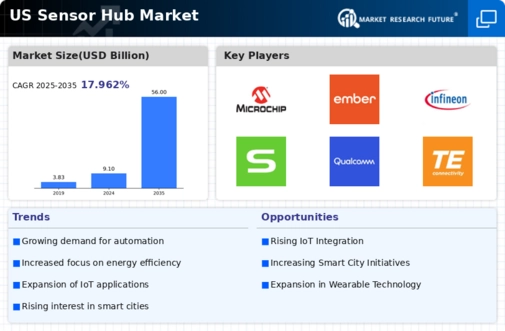Growth in Automotive Applications
The sensor hub market is poised for growth due to the increasing integration of sensor technology in automotive applications. As vehicles become more advanced, the demand for sensor hubs that can process data from various sensors is rising. In 2025, the automotive sensor market is projected to reach approximately $30 billion in the US, with a significant portion attributed to sensor hubs. These hubs are essential for enabling features such as advanced driver-assistance systems (ADAS), which rely on real-time data processing for safety and navigation. The automotive industry's shift towards electric and autonomous vehicles further amplifies the need for sophisticated sensor hubs capable of handling complex data streams. This trend indicates that the sensor hub market will likely play a crucial role in the evolution of automotive technology, enhancing vehicle performance and safety.
Expansion of Smart Home Applications
The sensor hub market is significantly influenced by the expansion of smart home applications. As more households adopt smart devices, the demand for sensor hubs that can manage and integrate these devices is increasing. In 2025, the smart home market in the US is expected to surpass $100 billion, creating a substantial opportunity for sensor hub manufacturers. These hubs serve as the central point for communication between various smart devices, such as thermostats, security cameras, and lighting systems. The ability to control multiple devices through a single interface enhances convenience and efficiency for consumers. Furthermore, advancements in wireless communication technologies, such as Zigbee and Z-Wave, are facilitating the integration of sensor hubs into smart home ecosystems. This trend suggests a promising trajectory for the sensor hub market, as it becomes integral to the functionality of smart homes.
Emergence of Smart Cities Initiatives
The sensor hub market is likely to experience growth due to the emergence of smart cities initiatives across the US. As urban areas seek to enhance infrastructure and improve quality of life, the integration of sensor technology into city management systems is becoming essential. In 2025, investments in smart city projects are projected to reach $100 billion, creating a substantial demand for sensor hubs that can manage data from various urban sensors. These hubs play a critical role in applications such as traffic management, waste management, and environmental monitoring. By enabling real-time data processing and communication between sensors, they contribute to more efficient city operations. This trend indicates a promising future for the sensor hub market, as it aligns with the broader goals of sustainability and urban innovation.
Rising Demand for Wearable Technology
The sensor hub market is experiencing a notable surge in demand driven by the increasing popularity of wearable technology. As consumers become more health-conscious, devices such as fitness trackers and smartwatches are gaining traction. In 2025, the wearable technology segment is projected to reach a market value of approximately $60 billion in the US. This growth is likely to propel the sensor hub market, as these devices require advanced sensor integration for functionalities like heart rate monitoring and activity tracking. The need for compact, efficient sensor hubs that can process data in real-time is becoming paramount. Consequently, manufacturers are focusing on developing sensor hubs that can seamlessly integrate with various wearable devices, enhancing user experience and functionality. This trend indicates a robust future for the sensor hub market, as it aligns with the broader shift towards health and fitness monitoring.
Increased Focus on Industrial Automation
The sensor hub market is benefiting from the increased focus on industrial automation across various sectors. As industries strive for greater efficiency and productivity, the integration of sensor technology into manufacturing processes is becoming more prevalent. In 2025, the industrial automation market in the US is expected to exceed $200 billion, driving demand for sensor hubs that can facilitate data collection and analysis. These hubs enable real-time monitoring of equipment and processes, allowing for predictive maintenance and improved operational efficiency. The ability to connect multiple sensors and devices through a centralized hub is essential for optimizing production lines and reducing downtime. This trend suggests that the sensor hub market will continue to expand as industries increasingly adopt automation technologies to remain competitive.























Leave a Comment